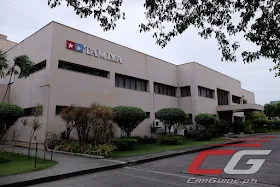When Yoshio Tamiya, the owner of a sawmill and lumber supply company based in Shizuoka City decided to use his surplus wood and delve into making model ships and airplanes, little did he know that he’ll become a household name. Plastic may have replaced wood as the creative medium, but every child knows what the “Two Stars” stands for. For many, building Tamiya scale models or racing remote controlled or RC cars have eaten up entire weekends or vacations, so it’s just fitting to see them being made. And get this: you don’t have to travel to Japan to see them being boxed up; one just needs to travel to Cebu, where Tamiya’s largest factory is located.
There are many stories as to how Tamiya got the famous Star Mark logo. One version says the red stands for creativity and passion, while the right is for youth and sincerity. It’s a fitting tale, given how Tamiya’s story saw it rise from obscurity to the world stage specifically at the 1967 Nuremberg Toy Fair in Germany, where it wowed show goers with their 1/12 scale model of the 1965 Honda RA272 Formula One racer—the first Japanese car to win a Formula One Grand Prix. Of course, the Tamiya stars could also stand for the company’s unique two-prong strategy that’s proven to be successful.
The first is an integrated company structure. From conceptualization to production to packaging, Tamiya does everything in-house. This enables the company to keep quality up and it shows in the accuracy and detailing of its plastic models. Not only does Tamiya have its designers scurry through countless photographs and travel the world to see the actual vehicle to be replicated up close, but they go so far as to purchase the actual vehicle itself. Since the 1960s, Tamiya has been making their own molds, enabling them to reproduce scale models in minute detail, down to rivets, screws, and weld joints.
This, almost bordering on the obsessive, attention to the production process is seen at Tamiya’s assembly in Lapu-Lapu City, Cebu. Established in September of 1994, it currently produces 90 percent of Tamiya’s model line by volume (the remaining 10 percent is done in Japan). After passing the guard house of the export processing zone, it feels like being transported to a factory in industrial Japan. Each worker, dressed in uniform, goes about their work in an efficient and quiet manner. The normally chatty Filipino workers merely smile as they go about sorting through the newly molded plastic, checking them for any defects. Each station is brightly lit, ensuring no dimple or dent escapes their highly trained eyes. Over at the painting department, the unmistakable whiff of modeling paint fills the room. Each worker here hand assembles the “Master Works” models by hand. Using the thinnest of brushes, they apply every small detail, some of which won’t even be seen by the model’s owners since they’ll be encased in glass. Still, no shortcuts are allowed here since each model is compared to a sample in a cabinet. That cabinet is in itself a time capsule of Tamiya’s greatest hits. Appropriately, the first model that greets you is the Honda RA272 Formula One car; only this one is hand-finished by Cebuano artisans.
The second star in Tamiya’s logo could very well mean the company’s commitment to delivering a rich customer experience. With a mission to make the whole modeling experience truly rewarding, Tamiya believes that that first RC car or model kit will ultimately become the first of many. To this end, they’ve enriched the modeling experience by keeping their fans in the loop with in-house publications and catalogues. They’ve also established events such as the annual Tamiya Fair which has made Shizuoka City the model kit capital of the world.
Even when choosing partners, Tamiya has always gone for those who share the same passion and enthusiasm as they have. As the Philippines’s exclusive distributor, Lil’s Hobby Center has been the go-to place for everything Tamiya. Since the 1970s, Shakespeare Chan and his wife have personally greeted both kids and diehard modelers alike. Though Mr. and Mrs. Chan weren’t blessed with any children, their passion to bring the joy of modeling and RC cars passed on to the next-generation of Tamiya authorized dealers: Justin Uy, Robertson Sy Tan, and Albert Go. Mr. Uy represents Hobbes and Landes, a unique specialty store that evokes the sense of creativity and wonder in children and reminisce a playful childhood for adults. Meanwhile, Mr. Sy Tan and Mr. Go run the country’s largest chain of automotive accessories and car-related products: Blade Auto Center. Through their combined efforts, they have brought Tamiya to more than 30 outlets nationwide, hopefully to inspire a new generation to take up the hobby of modeling and RC cars.
The wide-eyed expressions of joy and wonder at seeing their latest scale models and RC cars unboxed by modelers, hobbyists, and collectors will only serve to fuel Tamiya’s passion and determination to keep scale modeling going. This year marks the 50th anniversary of Tamiya’s continuous participation at the Nuremberg Toy Fair. After wowing the global stage with its Honda RA272 Formula One scale model, Tamiya aims to continue perfecting every step of the modeling experience. It shows in every effort the company makes from the one thousand men and women in Cebu who help manufacture them to their partners who help distribute and sell them. Passion flows in Tamiya’s veins and this is something that will keep them forever young.






























No comments:
Post a Comment
Feel free to comment or share your views. Comments that are derogatory and/or spam will not be tolerated. We reserve the right to moderate and/or remove comments.